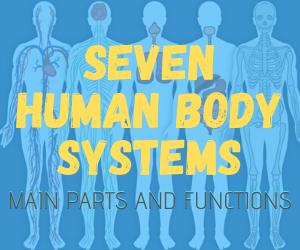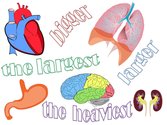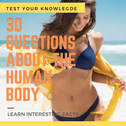Category: Topics in the syllabus
The body is made up of many systems that all work together as a unit. Each body system has a particular function. Let’s see their functions and parts.
Digestive system
Function: The digestive system takes nutrients from the food and turns it into energy.
Parts
Respiratory system
Function: The respiratory system provides oxygen to all body’s cell and gets rid of carbon dioxide.
Parts
Circulatory system
Function: The circulatory system transports blood and oxygen from the lungs to all body’s cells.
Parts
Nervous system
Function: The nervous system sends signals from the brain to the rest of the body.
Parts
Skeletal system
Function: The skeletal system gives the body structure, provides motor power for the movement, protects organs, stores minerals, and produces red blood cells.
Parts
Muscular system
Function: The muscular system helps the body move and gives it shape, heat, and strength.
Parts
Excretory system
Function: The excretory system eliminates the body’s waste.
Parts
Digestive system
Function: The digestive system takes nutrients from the food and turns it into energy.
Parts
- Mouth. The mouth chews and breaks the food down into small pieces to be digested.
- Teeth. The teeth chop the food into small pieces.
- Tongue. The tongue rolls and moves the food in the mouth.
- Salivary glands. The saliva moistens and lubricates the food.
- Pharynx. The pharynx receives the food from the mouth when you swallow.
- Esophagus. The esophagus delivers food to the stomach.
- Stomach. The stomach digests the food with a mixture of digestive enzymes and acid.
- Small intestine. The small intestine absorbs the nutrients from the food.
- Pancreas. The pancreas secretes digestive enzymes into the small intestine.
- Liver. The liver processes the nutrients from the small intestine and secretes the bile for the digestive process. It also filters toxins from the blood.
- Gallbladder. The gallbladder stores and recycles excess bile.
- Large intestine. The large intestine absorbs water and breaks down waste.
- Rectum. The rectum holds the stool (fecal matter) until it is evacuated.
- Anus. The anus controls the expulsion of the feces.
Respiratory system
Function: The respiratory system provides oxygen to all body’s cell and gets rid of carbon dioxide.
Parts
- Nose and nasal cavity. The nose and the nasal cavity inhale and filter air entering the body.
- Pharynx. The pharynx ensures that air can pass into the trachea.
- Larynx. The larynx prevents food or drinks from being aspirated in the respiratory tract.
- Trachea. The trachea filters the air before it goes to the bronchi.
- Bronchus. The bronchus connects the trachea to the lungs.
- Lungs. The lungs provide oxygen to all body’s cell and exhale carbon dioxide.
- Alveolus. The alveolus exchange carbon dioxide for oxygen.
- Diaphragm. The diaphragm contracts and relaxes the thoracic cavity in order to let the air moves into and out of the lungs.
Circulatory system
Function: The circulatory system transports blood and oxygen from the lungs to all body’s cells.
Parts
- Heart. The heart pumps the blood to the different parts of the body.
- Arteries. The arteries carry oxygenated blood to organs and cells in the body.
- Veins. The veins carry deoxygenated blood from parts of the body back to the heart.
- Blood. The blood carries water, oxygen, nutrients, and waste products to and from the body’s cells.
- Lungs. The lungs send oxygen-rich blood to the left side of the heart.
Nervous system
Function: The nervous system sends signals from the brain to the rest of the body.
Parts
- Brain. The brain receives input from the sensory organs, interprets that information, and guides the response to it.
- Spinal cord. The spinal cord relays information to and from the brain.
- Nerves. The nerves carry signals from the body to the spinal cord or brain.
Skeletal system
Function: The skeletal system gives the body structure, provides motor power for the movement, protects organs, stores minerals, and produces red blood cells.
Parts
- Skull. The skull protects the brain.
- Clavicle. The clavicle provides support and movement of the arms.
- Ribs. The ribs protect the lungs.
- Radius. The radius enables the hand to rotate and be flexible.
- Phalanges. The phalanges give the movement of the fingers and toes.
- Vertebral column. The vertebral column protects the spinal cord.
- Pelvis. The pelvis allows movement of the body, especially walking, running, sitting, and kneeling.
- Femur. The femur transmits forces from the tibia to the hip joint.
- Tibia. The tibia supports the movement of the leg.
Muscular system
Function: The muscular system helps the body move and gives it shape, heat, and strength.
Parts
- Heart. The heart pumps the blood to the different parts of the body.
- Triceps. The triceps extend the elbow and straighten the arm.
- Biceps. The biceps help the arm to bend at the elbow.
- Abs. The abdominal muscles provide postural support and protect internal organs.
- Quadriceps. The quadriceps give movement of the knee.
Excretory system
Function: The excretory system eliminates the body’s waste.
Parts
- Kidney. The kidneys filter extra water and toxins such as urea from the blood.
- Liver. The liver filters toxins from the blood.
- Large intestine. The large intestine breaks down waste.
- Skin. The skin excretes sweat through sweat glands throughout the body.
- Lungs. The lungs get rid of the carbon dioxide.
- Ureter. The ureter carries urine from the kidney to the urinary bladder.
- Urinary bladder. The urinary bladder collects waste excreted by the kidneys.
- Urethra. The urethra excretes the urine out of the body.
What to read next




